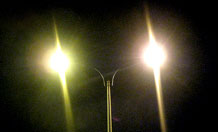
Councils want to reduce overnight street lighting to decrease their carbon footprint
Streetlight policies could cast a shadow over wildlife
Scientists have conducted the first study into the ecological effects of a variety of energy-saving options to reduce overnight street lighting. Among the findings, researchers discovered that introducing “whiter” LED lights would be likely to increase the environmental impact.
They are being considered in some areas as an alternative to traditional lighting methods.
The study was carried out by the University of Exeter’s Environment and Sustainability Institute. The research, carried out in collaboration with Natural England, comes as councils and organisations are seeking cost-effective low-carbon lighting solutions which will change the urban lightscape dramatically over the next few years.
Professor Kevin Gaston, who led the research, said: “This study is designed to help address the considerable challenge of developing lighting strategies for the future. It is a delicate balance to find a solution which meets the need for human comfort and safety, reduces energy consumption and carbon emissions, and minimises ecological impacts, but it is a question which must be tackled. Discovering more about the ecological effects of various lighting technology options can only help to resolve these conflicts.”
The research, funded by the European Research Council under the European Union’s Seventh Framework Programme, also concluded that maintaining or increasing areas which are not artificially lit was likely to be the most effective option in ecological terms, but could clash with other social and economic objectives.
Decreasing the duration of lighting would reduce energy costs and carbon emissions, but would be unlikely to alleviate many impacts on animals, as peak times of demand for lighting frequently coincide with peaks in the activities of nocturnal species.
Reducing the trespass of lighting would create dark refuges that animals can move into and exploit.
Decreasing the intensity of lighting will reduce energy consumption and limit both light pollution and the area impacted by high-intensity direct light, the researchers concluded.
Professor Gaston said: “This study will help to inform decision-makers of the potential impact of the policies that many are in the process of adopting right now. We are currently carrying out more research to examine the effects of each option in more detail, as these decisions will help shape our night-time ecology.”
Date: 15 November 2012
